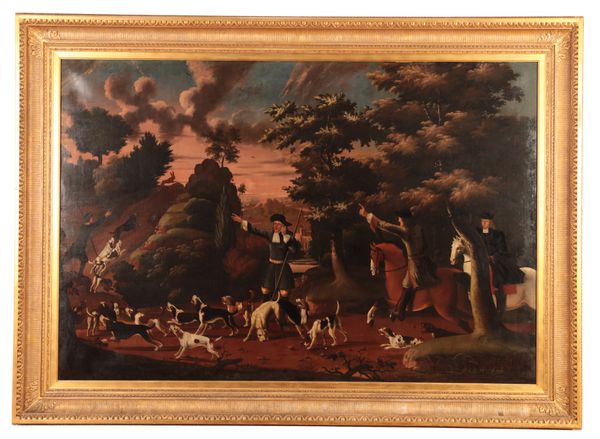huntsman gesturing to their hounds to follow their quarry up an inclined bank, oil on canvas, 145cm x 216cm
Provenance: Barker Mills family, sale of Mottisfont Abbey circa 1870
thence by descent to the Dalgety family of Lockerley Hall, Hampshire.
| Estimate: | £10,000 - £20,000 |
Note: A drawing of similar composition by Frances Barlow is in the Ashmolean Museum, Oxford, which was included in a set of a 1671 set of 12 etchings of Barlow’s works by Wenceslaus Holler entitled ‘Several Ways of Hunting , Hawking , and Fishing , invented by Francis Barlow, engraved by W. Hollar, 1671’, published by John Overton.
Francis Barlow
Born in Lincolnshire, Barlow was known as 'the father of British sporting painting' as the country's first wildlife painter, beginning a tradition that reached a high-point a century later, in the work of George Stubbs. As well as works depicting natural history and hunting and recreation, Barlow was also a pioneer in the history of comics, with the creation of 'A True Narrative of the Horrid Hellish Popish Plot' (circa 1682), a picture story about the life of Titus Oates and the Popish Plot, which is told in a series of illustrated sequences where the story is written underneath them and the characters depicted on those images use speech balloons to talk. While it is not the first example of its kind in history, it is one of the oldest which is signed.
Hugh James Rose observed in the early 19th century that Barlow's "chief merit [. . .] as a designer, lay in his exactness in the portrayal of birds, fishes, and animals of all kinds, which are executed in a spirited, and in many instances a masterly manner." and art historian Mark Hallett noted that Barlow's time is British art's "forgotten era" - one that "has tended to be overshadowed by the achievements of earlier artists, such as Van Dyck, or those that came later, such as Hogarth"; Hallett finds this unjust: Barlow made a significant contribution to what "in reality [. . .] was a remarkably rich, vibrant and cosmopolitan period for the visual arts in Britain."

